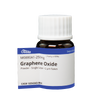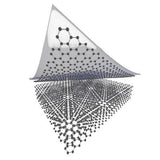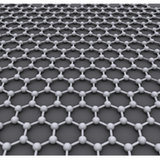What is Graphene Oxide?
Graphene oxide (GO) is a two-dimensional material with oxygen-functionalized surfaces, derived from graphite. Its unique properties include easy dispersion in polar solvents and tunable electrical and optical behaviors. GO can be further modified for a wide range of applications, from optoelectronics to water purification. For these reasons, GO opens up new possibilities in material science and nanotechnology, promising revolutionary advances across various industries.
Graphene Oxide Structure
2D graphene oxide (GO) is a single layer of 3D graphite oxide (or graphitic oxide) - just like 2D graphene is a single layer of 3D graphite. Graphite oxide is produced by treating graphite with oxidizers and acids. This process results in the oxygen-containing functional groups:
- Epoxy groups (C-O-C)
- Hydroxy groups (-OH)
- Carboxylic acid groups (-COOH)
These groups appear randomly on the GO layers. As a result, GO contains carbon, oxygen, and hydrogen in variable ratios. The ratio of carbon and oxygen helps you determine the extent to which the oxidation was successful.

The structure and properties of graphene oxide are dependent on its synthesis method and the degree of oxidation. GO maintains a similar layered structure to graphite, but the spacing between layers is almost two times larger (~0.7 nm). This increased spacing is due to the polar nature of the functional groups, which cause a repulsive force between the layers. The space between layers of graphite oxide can be changed by varying the amount of oxygen-containing functional groups and the amount of water the material is exposed to.
You can access a single or a few layers of graphene oxide via the delamination/exfoliation of graphite oxide. This can be done in a number of ways, such as increasing the pH of graphite oxide in solution or by sonicating it. These methods can be much more gentle than the techniques used to access graphene therefore the GO layers are less damaged. The atomically thin, 2D nature of graphene oxide means it has a much larger surface area compared to layered graphite oxide.
Properties and Applications
The polar functional groups of graphene oxide give it distinct properties compared to other 2D materials (especially graphene).
Easily Solution Processed

Graphene oxide is easily dispersed within water and other polar organic solutions due to its polar functional groups. You can therefore process GO at higher concentrations than graphene (up to 5 mg.ml-1). This has opened it up for use in solution process-based applications such as optical coatings, transparent conductors, thin-film batteries, chemical resistant coatings, water purification, and many more.
Tunable Properties
You can dynamically tune the performance of graphene oxide as an electrical insulator by varying the number of oxygen-containing groups. Random oxidation on the graphene oxide sheets disrupts the sp2 bonding networks and π-conjugation. This interrupts the flow of electrons and reduces conductivity. To increase conductivity, you can remove oxygen containing functional groups by chemical or physical reduction reactions. This reinstalls the delocalized hexagonal lattice structure. As GO is easily dispersed in solvent, you can perform these reactions in solution. This results in potentially monodispersed graphene or reduced graphene oxide particles.

The optical properties of graphene oxide are linked to its electronic properties. Therefore, you can also tune the optical properties of graphene oxide by varying the amount of oxygen containing functional groups.
Functionalized Graphene Oxide
You can functionalize graphene oxide further, adding polymers, nanoparticles, biomolecules, metals, fluorescent compounds and much more (Yadav et al., 2022). Further functionalisation can occur both covalently (physical attachment) and non-covalently (adsorbed). This means you can introduce a whole host of surface chemistries, which allows you to tailer GO for a given application. These applications include optoelectronics, drug delivery, chemical sensors, membrane filtration, flexible electronics, solar cells and more.
| Functionalization | Application | Resulting Properties |
| PEGylation | Tissue Engineering | Biocompatible |
| Antibodies | Biosensing, Drug Delivery | Analyte selectivity |
| Fluorophore | Biomedical Imaging, Drug Delivery | Fluorescence |
| Gold Nanoparticles | Biosensing | Different electrochemical properties, catalyst |
| Metal Oxide Nanoparticle | Chemical Sensing | Different electrochemical properties, catalyst |
| Titanium Oxide | Membrane Filtration | Photocatalyst |
Graphene Oxide Powders

- Easily Dispersed
- High Purity
- Low Price
Available from £90
Learn More
References
Aliyev, E. et al. (2019). Structural Characterization of Graphene Oxide: Surface Functional Groups and Fractionated Oxidative Debris, Nanomaterials (Basel), 9(8), doi: 10.3390/nano9081180
Yadav, S. et al. (2022). An Update on Graphene Oxide: Applications and Toxicity, ACS Omega, 7(40), doi: 10.1021/acsomega.2c03171

